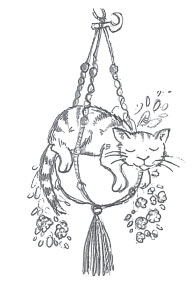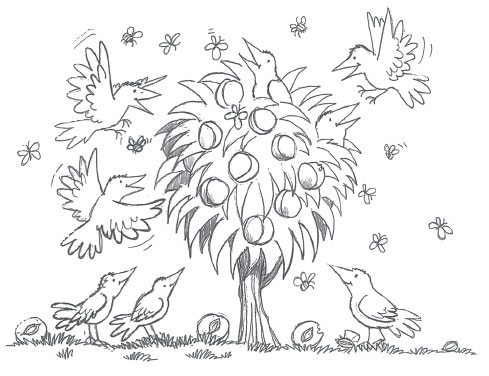Chapter 6
The ‘I don’t have a garden’ Garden

Fast fruit to grow in a tub
I said you don’t need a garden to have a garden. You can grow lots of things in pots or even tubs.
Watermelons and rockmelons are great in tubs. Strawberries, rhubarb, tamarillos and cumquats can be grown in a tub too – look up how to grow and eat them in Chapter Five.
You can grow passionfruit in a tub too (see page 33). Just make sure you give it a stick so it can climb up onto a fence or the railing around your verandah or balcony.
Other things to grow in pots:
- Parsley.
- Bush pumpkins (plant them from spring to Christmas).
- Zucchini.
- Tomatoes (plant them from spring to Christmas and tie them up to a stake so they don’t fall over. Try tiny little cherry tomatoes – you just eat them whole as they ripen.).
- Silver beet and lettuces.
- Mint (plant it at any time).
- A broccoli plant (plant it in late January or early February).

I don’t have a tub or any pots – and I
don’t have any money either!
Okay, start looking for other things to grow your plants in!
- Styrofoam boxes from the supermarket are great for strawberries or watermelons. Just make sure they have holes in the bottom or they’ll fill up with water!
- Cut the tops off large milk containers and cut a few holes in the bottom.
- Anyone got a spare bath tub? I once grew tomatoes in an old computer – well, I took the innards out first!
As long as it will hold dirt – and there is somewhere for the water to drain out – you can plant stuff in it. Just think of all the everyday things that could be used for plants: holey rubbish bins, old wheelbarrows, buckets with a split in the side, leaky plastic swimming pools…

How do I get some dirt?
You can buy ‘potting mix’ from the garden centre.
You can ask some nice gardener if they can spare some.
You can make compost. This turns scraps of rubbish into the best soil you can get.
You can also buy a worm farm and have the worms turn garbage into compost. Most worm farms have instructions and they’re fun!!

How to make compost
There are lots of ways to make compost. This is just one way.
Make a big pile of: fallen leaves; weeds; cabbage, lettuce or celery leaves; old flowers.
If you are making compost on a patio, because you don’t have a garden, you can spread it out on plastic so you don’t make too much of a mess.
Step 1. Chop everything into small pieces. (Even if you don’t chop everything up it will still turn into compost – it will just take longer.)
Step 2. Sprinkle blood and bone (from the garden centre) on the heap.
Step 3. Every day or two, mix all the stuff together again so it’s all mixed up and turned over and receives lots of air.
Step 4. In about two weeks it’ll all have shrunk into a small pile. Leave it alone for another two weeks or so. It won’t quite look like dirt yet – that will take a few months – but you can mix it with real dirt or potting mix now and plant your seeds!

Planting a tub
Step 1. Find a tub.
You can buy old wine half-barrels at garden centres – but they are expensive. Make sure they have holes in the bottom for water to drain out or the tub will fill up with water when it rains!
I used to grow plants in an old bathtub. Sometimes you can buy cheap ones. Just make sure it’s tilted up so the moisture that gathers at the bottom runs down the plug hole – or you’ll end up with a swamp instead of a garden.
Step 2. Put rocks in the bottom. This helps the moisture drain out – because if you just fill it up with soil, the dirt will clog the holes and it’ll fill with water.

Step 3. Fill with soil or good potting mix – don’t just get cheap stuff, because it’s mostly sand and bark. Look for an ‘Australian Standard’ mark on the bag. If you can, mix good soil with good potting mix.
Step 4. If you want to, you can add ‘water retaining’ crystals to the top layer of soil. These swell up with water when you wet them – it looks incredible – and as the soil dries out these help keep the plants moist.
Step 5. Plant seeds or seedlings in your tub.
Step 6. Buy some coconut fibre at the garden centre. Spread this over the dirt in the tub around the plants.
If you don’t do this, the dirt will slowly turn into stuff like concrete. (Plants don’t really grow in concrete.)

Step 7. Water your plants every couple of days – pots and tubs dry out much faster than gardens. They don’t hold as much food for your plants either…so scatter on a slow release plant food – ask at the garden centre and they’ll sell you one, then just follow the instructions on the back.
I can’t tell you how to use them because different plant foods work in different ways. I make my own, but that’s too complicated to go into here. If you really want to know how to do it, you can read my book Plant Food: 1642 ways to feed your garden.
Dwarf fruit
Dwarf fruit aren’t tiny fruit – they are small trees that have normal-sized fruit. You plant and look after dwarf fruit trees just like other fruit trees (see Chapter Three).
You can get dwarf apples, dwarf peaches and dwarf nectarines. Unlike ‘normal’ apples, peaches and nectarines they don’t have to be pruned and if you think the birds are going to eat the fruit or fruit fly are going to lay maggots in them you can cover them with netting.
(You can cover any tree with bird or fruit fly netting of course, but if it’s a big tree this takes lots of net…and you try getting a net over a giant mango tree!)
Dwarf fruit are great in big pots and most will give you fruit the same year you plant them.
